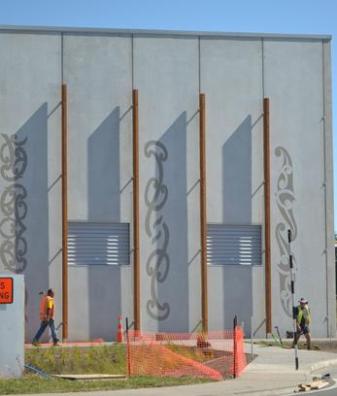Ornamental nationalism for the modern Maori
I initially had a bad reaction to Tim Codyre’s opinion piece in the January 2014 edition of Architecture New Zealand. Granted, my first reading was clouded by my preconceptions of this journals poor treatment, elucidation, or at times even recognition of Maori architecture and design. To read a piece that seemed to argue for a return of Maori-inspired motifs and craft pieces to adorn modern buildings as a way to advance a New Zealand identity simply confirmed my preconceptions.
“Inevitably we will embellish our furniture and buildings with design motifs that are sourced here”, Codyre writes, with all its overtones of a reach for nationalism and its accompanying coherent identity. It reminded me of Francis Pound’s investigation into art and New Zealand’s national identity, where he said “There is no doubt that the New Zealand modernists’ main motive for using the forms of Maori art was to turn them into signs of New Zealand place.” (p.271) Back then it was predicated on primitivism, a desire to learn from art regarded as original, primary, or more real. Part of the allure of the primitive is its close connection to nature, unsullied by industrialisation or mass marketing.
But Pound points out that the last 40 years saw the rise of a newly powerful Maori discourse, creating the “unavoidable presence of a Maori voice”. This means it is “no longer possible to presume a single identity for a New Zealand culture, as the Nationalists had, with their unitary ‘our’, ‘we’ and ‘I’.” (p.364) So where does Codyre fit? Is he simply suggesting a misguided return to a reach for nationalism that appropriates Maori design motifs? Or is he tapping into one of the latest architectural trends and giving this a distinctly New Zealand flavour?
Ornament is having a renaissance of sorts in the architectural world, and generating aesthetic debate along the way. Douglas Murphy wrote in the November 2009 Icon Magazine that the new decorative tendencies are a reaction to the smooth, abstract digital architecture designed using parametric scripting. He quotes Neil Spiller, ““The Victorians had the battle of the styles, and this had a lot to do with God, but today we have a different set of criteria; you have the language of naturalism, giving us a certain digital art nouveau with nature as a moral replacement for god in some ways.” Modern technologies such as 3D printers, laser cutters and CAD-driven milling machines can replicate and reproduce complex patterns for facades as quickly as the architects can download the files in the right formats.
So is ornament no longer a crime, or is it a case of architects and designers turning criminal? The Telegraph wrote “Today’s wave of ornamented buildings, however, avoid the added-on look by being almost uniformly flat and taking a simple geometric form. Their patterning does not destroy the overall mass of the building and it is usually a repeated pattern that’s still comfortingly (from a modernist’s perspective) redolent of mechanisation and modernity.”
One common use of ornament in New Zealand is the imprinting of patterns into concrete slabs. Athfield Architects turned the whare inside out at the cultural centre for Waiwhetu marae. Patikitiki patterns were impressed into the concrete panels, mimicking tukutuku panels that would normally appear on the inside of a wharenui. Tennent Brown followed a similar path for Nga Purapura at Otaki, sandblasting Maori design motifs into their concrete walls. Each of these help to break up the cold blank mass of concrete whilst also serving to announce these as Maori buildings. This is pure adornment (ornament?), with an uncertainty about whether it is done to proudly announce identity or to help clarify for those who would not normally be able to tell. There is a hint of the tattoo whose wearer carries a similar uncertainty (but here there is no incision to draw reference to moko, it is a very different process of impression and blasting).
You could argue that Waiwhetu cultural centre and Nga Purapura are providing a distinctly Maori flavour (identity?) through such adornment, although this probably exists without the need for ornament. Warren & Mahoney’s Supreme Court building is a different story. The Court’s bronze facade screen is “strongly influenced by the Maori idea of Pohutakawa and Rata trees symbolising both shelter and leadership.” Here we get closer to what Icon Magazine and The Telegraph were talking about, a repeated pattern redolent of mechanisation and modernity yet still utilising the language of naturalism. It also matches Codyre’s call for an ornament drawn from our nature, drawing on indigenous culture to create a building that (in theory) represents a New Zealand identity.
But of the three examples noted here, the Court is the weakest. Not technically – the bronze work and patterning is complex. It does stink of a form of nationalism appropriating Maori design motifs to force the point that this is a New Zealand building. The fact that the rest of it speaks little of New Zealand shows the difficulty architecture (and the court system) has – a cultural facade cannot hide the colonial beast lying beneath. Failed embellishment, awful ornament. If this is ‘our’ own language of ornament, then we have to seriously question the ‘our’. At least Waiwhetu and Nga Purapura carry their embellishments and ornamentation as part of a Maori voice rather than trying to convince us of a single national identity.
About this entry
You’re currently reading “Ornamental nationalism for the modern Maori,” an entry on sub.sist
- Published:
- May 22, 2014 / 9:04 am
- Category:
- Uncategorized



No comments yet
Jump to comment form | comment rss [?] | trackback uri [?]